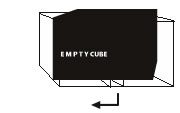MARK THEMANN
JUNE, 25, 2014

CONTACTS
www.markthemann.com
EXHIBITION INFORMATION
ZONE
Instalation/Performance
Participation: Vasco Appleton
Acknowledgments: Vasco Appleton, Vera Appleton, João Appleton
Images © Pedro Tropa
Think And Roll The Dice
By installing an informational display sign inside the structure of EMPTY CUBE, Mark Themann sets in motion an inevitable dialogue with the viewer. Our reading of his sentences, which are successively switched by another agent, a young man who replaces them at certain intervals, does not demand a response from us. Neither is it aimed at the artist or to some other person in the space of the gallery, whose architectural structure identifies it as an exhibitive space, which simultaneously hosts the temporary presence of EMPTY CUBE. In addition, the placard does not constitute some kind of information booth where the artist displays one or more texts, which might act as pointers to the audience. On the contrary, it defines a zone that possesses a specific quality, a zone (also mentioned in the project's original title: ZONE) that acts as a territory where thought is the object of an eventual confrontation which may occur in that same territory.
Such is the project’s quality: it turns the white cubic structure into a zone where the act of thinking, either sudden or deliberate, may, or may not match, the sentence that at any given moment, identifies that space as a place. This is a place where thought comes into contact with a conflict between the freedom of thinking in a neutral white space and the paradoxes generated within that space by the changing descriptions displayed in the installed sign. We have, for instance, a 'Zone of all that which mimics thought' (one of the sentences that are part of this work by Mark Themann), a place which, utopian though it is, ultimately questions and disturbs the individual who reads the sentence. What happens here is not a direct relationship with an other. Rather, what happens is a relationship between ourselves as individuals and a change of condition in our dialogue with ourselves. On the other hand, the artist explores a number of (post-) conceptual practices within a critical path, as he works on the double legacy of the artwork's dematerialisation and of the 'white cube' ideology, whose most attentive proponent was Brian O’Doherty. In a passage from his book Inside the White Cube, The Ideology of the Gallery Space, this author states: 'We have now reached a point where we see not the art but the space first […] An image comes to mind of a white, ideal space that, more than any single picture, may be the archetypal image of 20th-century art. And it clarifies itself through a process of historical inevitability usually attached to the art it contains'1 . However, three decades earlier John Baldessari had written on a canvas2 the following words: 'EVERYTHING IS PURGED FROM THIS PAINTING BUT ART, NO IDEAS HAVE ENTERED THIS WORK'. These two historical landmarks give us an idea of the sphere in which Themann's work develops, be it in terms of its conceptual concerns or of the subtle alteration of an exhibitive context. What then, is the status of the work of art here, and what is the condition of the viewer as an essential element within the gallery's typified space? Why is a very young man tasked with replacing the paper sheets bearing sentences that compel us to a moment of philosophical introspection?
These are some of the questions that are part of the materials raised by Mark Themann's presented work. These emerge out of the temporality that is brought to us by his work's performativity. It is one which takes into consideration the absurdity and abstract nature of the methodologies that create order via language and abide in a poetic, mutant duality. In the same way, the temporal metric of the performance relies on the previous determination in regards to the succession of the sentences, that operate on the space's condition. The replacement of each sentence on the front (and back) of this rather un-museological-looking textbased signage has been randomly predetermined by a roll of the dice. A seemingly playful approach, that nonetheless recovers the imprevisibility of a determination and at the same time engenders the valuable need to control a situation and a territory, one in which thought confronts itself, putting itself to the test as someone thinking themselves.
João Silvério
June 2014
The sentences that made up the performance:
Zone of all that which has been thought
Zone of all that which refuses to be thought
Zone of all that which cannot be thought
Zone of all that which remains to be thought
Zone of all that which asks to be thought
Zone of all that which mimics thought
Zone of all that which wants to be thought
Zone of all that which abolishes thought






